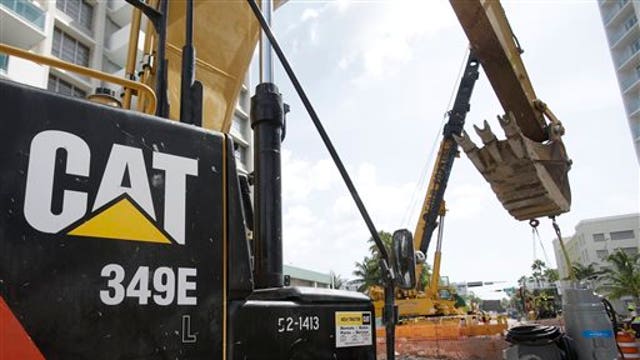Caterpillar Lifts 2015 Outlook, But Challenges Remain
Caterpillar (NYSE:CAT) lifted its earnings outlook for 2015 to cap a stronger-than-expected first quarter, but the equipment maker maintained a cautious tone amid weakness in the mining and oil industries.
The world’s largest manufacturer of construction and mining equipment said Thursday it earned $1.11 billion, or $1.81 a share, during the first three months of the year. Earnings were up 20% compared to a year-ago profit of $922 million, or $1.44 a share. Revenue fell 4% to $12.7 billion.
Analysts were looking for earnings of just $1.35 a share. Caterpillar also beat Wall Street’s revenue forecast of $12.38 billion.
Peoria, Ill.-based Caterpillar now expects to post a per-share profit of $4.70 for the full year, up 10 cents from previous guidance.
The company’s stock was up 56 cents, or 0.7%, at $85.43 in recent trading. Caterpillar is down 6.6% since the start of the year, compared to a 2.3% gain for the broader S&P 500.
Results are still on pace to take a step back from last year’s bottom line. Caterpillar was able to book a slightly higher profit of $5.88 in 2014, as cost cuts helped offset mining and construction headwinds. However, those same challenges remain, while new pressure is coming from the oil and gas industry.
“We are facing a challenging rest of the year. We are not going to see a repeat of the first quarter the rest of the year,” Chairman and CEO Doug Oberhelman said on FOX Business Network’s Opening Bell with Maria Bartiromo.
In a note to clients, analysts at RBC Capital Markets said Caterpillar’s first-quarter report isn’t “thesis changing,” citing expected declines in sales to the energy industry.
Shrugging Off Strong Dollar
Oberhelman went on to say that Europe’s economy should respond well to a new bond-buying program in the region, while China should bounce back from its current slowdown.
“When the cycle turns, and it will…we typically go up pretty quickly,” Oberhelman added.
Caterpillar’s order backlog at the end of the first quarter was $16.5 million, a 15% decline year-over-year. That reflects a smaller book of future sales. During a conference call with analysts, executives said growth in locomotive orders partially offset oil weakness.
Caterpillar also expects its dealers to cut back on inventory over the course of the year.
Sales are particularly weak overseas, including Asia, Latin America and Europe. “The U.S. has been pretty good for us,” Oberhelman said.
Despite having a large international footprint, Caterpillar is downplaying the impact of a strong U.S. dollar that’s cutting into overseas profits for many multinational firms. Oberhelman said Caterpillar makes sure it has manufacturing operations wherever it sells equipment, an effort to protect the company from currency volatility.
Global Sales Slump
Mining continues to be a sore spot for Caterpillar. A global slump for coal and other commodities has forced miners to reduce spending on new equipment. In the first quarter, Caterpillar’s resource industries segment recorded a 9% drop in sales, despite stronger demand in North America.
Construction was a similar story, as North American gains were unable to offset global weakness. Segment sales fell 7%.
Energy and transportation revenue, including sales of oil-related equipment, was roughly even with last year’s quarterly results.
Caterpillar is keeping an eye on oil prices, which have taken a big hit as traders respond to swelling stockpiles and OPEC’s decision to maintain production levels. The oil cartel typically adjusts its output to keep global oil prices around $100 a barrel.
An executive with Weatherford International (NYSE:WFT), an oilfield services provider, recently told Bloomberg that half of the 41 fracking companies in the U.S. will shut down or be sold by the end of 2015.
“That’s not surprising,” Oberhelman said in response to the report. According to Oberhelman, struggles among oil and gas producers factored into Caterpillar’s decision to hold its 2015 sales outlook at $50 billion.
U.S. oil futures have fallen from $107 a barrel last summer to $57.68 a barrel Thursday, a new 2015 high. Prices have rebounded this spring from a low of $42.03 in March.




















